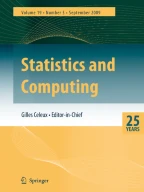Abstract
A new and innovative procedure based on time varying amplitudes for the classification of cyclical time series is proposed. In many practical situations, the amplitude of a cyclical component of a time series is not constant. Estimated time varying amplitudes obtained through complex demodulation of the time series are used as the discriminating variables in classical discriminant analysis. The aim of this paper is to demonstrate through simulation studies and applications to well-known data sets, that time varying amplitudes have very good discriminating power and hence their use in classical discriminant analysis is a simple alternative to more complex methods of time series discrimination.















Similar content being viewed by others
Explore related subjects
Discover the latest articles, news and stories from top researchers in related subjects.References
Alcock, R.J., Manolopoupos, Y.: Time-series similarity queries employing a feature-based approach. In: Seventh Hellenic Conference on Informatics, Ioannina, Greece (1999)
Andrzejak, R.G., Lehnertz, K., Rieke, C., Mormann, F., David, P., Elger, C.E.: Indications of nonlinear deterministic and finite dimensional structures in time series of brain electrical activity: dependence on recording region and brain state. Phys. Rev. E 64, 061907 (2001)
Bloomfield, P.: Fourier Analysis of Time Series: An Introduction. Wiley, New York (2000)
Chatfield, C.: The Analysis of Time Series: An Introduction, 6th edn. Chapman and Hall/CRC, New York (2004)
Chinganda, E.F., Subrahaniam, K.: Robustness of the linear discriminant function to nonnormality: Johnson’s system. J. Stat. Plan. Inference 3, 69–77 (1979)
Chinipardaz, R., Cox, T.F.: Nonparametric discrimination of time series. Metrika 59(1), 13–20 (2004)
Dudoit, S., Fridlyand, J., Speed, T.P.: Comparison of discrimination methods for the classification of tumors using gene expression data. J. Am. Stat. Assoc. 97(457), 77–87 (2002)
Fatti, L.P., Hawkins, D.M., Raath, E.L.: Discriminant analysis. In: Hawkins, D.M. (ed.) Topics in Applied Multivariate Analysis, pp. 1–71. Cambridge University Press, Cambridge (1982)
Feller, W.: An Introduction to Probability Theory and Its Applications, vol. 1, 3rd edn. Wiley, New York (1968)
Huang, H., Hernando, O., Stoffer, D.S.: Discrimination and classification of nonstationary time series using the SLEX model. J. Am. Stat. Assoc. 99(467), 763–774 (2004)
Kakizawa, Y., Shumway, R.H., Taniguchi, M.: Discrimination and clustering for multivariate time series. J. Am. Stat. Assoc. 93(441), 324–340 (1998)
Kannathal, N., Choo, M.L., Acharya, U.R., Sadasivan, U.R.: Entropies in detection of epilepsy in EEG. Comput. Methods Programs Biomed. 80(3), 187–194 (2005)
Lachenbruch, P.A., Mickey, M.R.: Estimation of error rates in discriminant analysis. Technometrics 10, 1–12 (1968)
Lawoko, C.R.O., McLachlan, G.J.: Some asymptotic results on the effect of autocorrelation on the error rates on the sample linear discriminant function. Pattern Recognit. 16, 119–121 (1983)
Maharaj, E.A.: Comparison of non-stationary time series in the frequency domain. Comput. Stat. Data Anal. 40, 131–141 (2002)
Maharaj, E.A., Alonso, A.M.: Discrimination of locally stationary time series using wavelets. Comput. Stat. Data Anal. 52, 879–889 (2007)
McLachlan, G.J.: Discriminant Analysis and Statistical Pattern Recognition. Wiley, Hoboken (2004)
Nigam, V.P., Graupe, D.: A neural-network-based detection of epilepsy. Neurol. Res. 26(1), 55–60 (2004)
Pham, D.T., Chan, A.B.: Control Chart pattern recognition using a new type of self-organizing neural network. Proc. Inst. Mech., 115–127 (1998)
Rawlings, R.R., Faden, V.B.: A study on discriminant analysis techniques applied to lognormal data. J. Stat. Comput. Simul. 26, 79–100 (1986)
Sakiyama, K., Taniguchi, M.: Discriminant analysis for locally stationary processes. J. Multivar. Anal. 90(2), 282–300 (2004)
Shumway, R.H.: Time-frequency clustering and discriminant analysis. Stat. Probab. Lett. 63(3), 307–314 (2003)
Shumway, R.H., Stoffe, D.S.: Time Series Analysis and Its Applications. Springer, Berlin (2000)
Young, P.C., Pedregal, D.J., Tych, W.: Dynamic harmonic regression. J. Forecast. 18, 369–394 (1999)
Acknowledgements
The author acknowledges the support of a grant from the Faculty of Business and Economics, Monash University, and the helpful comments by Professor Mervyn Silvapulle of the Department of Econometrics and Business Statistics, Monash University.
Author information
Authors and Affiliations
Corresponding author
Appendix: Distribution of the estimated time varying parameter, \(\widehat{R}_{t}\)
Appendix: Distribution of the estimated time varying parameter, \(\widehat{R}_{t}\)
The estimated time varying amplitude from complex demodulation \(\widehat {R}_{t} = |y_{t}|\) is equivalent to \(\widehat{R}_{t} = \sqrt{\hat{A}_{t}^{2} + \hat{B}_{t}^{2}}\) from local harmonic regression analysis. Consider the harmonic regression model in Eq. (1). As the least squares estimates, \(\hat{A}\) and \(\hat{B}\) of A and B respectively, are unbiased, it has been shown (Bloomfield 2000) that for Fourier frequencies, i.e., frequencies that are harmonic with the span of the data, their variances and covariances simplify to \(\mathit{var}(\hat{A}) = \mathit{var}(\hat{B}) = 2\sigma^{2}/n\), and \(\mathit{cov}(\hat {A},\hat{B})=0\), respectively. If it is assumed that the errors ε t are white noise, then as a result of the central limit theorem (Feller 1968, pp. 244–254), \(\hat{A}\) and \(\hat{B}\) as linear functions of the errors would be expected to be normally distributed with respective means and variances. However, while the variable \(\widehat{R} = \sqrt{\hat{A}^{2} + \hat{B}^{2}}\) is a function of other normally distributed variables, it distribution is not of a closed form as shown below.
Let \(X = \hat{A}^{2}\), \(Y = \hat{B}^{2}\) and Z=X+Y, then
f Y (y) is similarly obtained. Since X and Y are independent, by the convolution technique
Let \(W = \widehat{R} = \sqrt{\hat{A}^{2} + \hat{B}^{2}}\). Then \(W = \sqrt{Z} = g(Z)\) and w=g(z) defines a one-to-one transformation of the sample space of Z onto that of W and the derivative of z=g −1(w) with respect to w, is continuous and nonzero for w in the sample space of W. Then by the transformation technique, the density function of W=g(Z) is
Hence while \(W = \widehat{R} = \sqrt{\hat{A}^{2} + \hat{B}^{2}}\) is a function of normally distributed variables, it’s distribution is not of a closed form. Similarly the time varying amplitude \(W_{t} = \widehat {R}_{t} = \sqrt{\hat{A}_{t}^{2} + \hat{B}_{t}^{2}}\) and filtered versions of it do not have closed form distributions.
Rights and permissions
About this article
Cite this article
Maharaj, E.A. Classification of cyclical time series using complex demodulation. Stat Comput 24, 1031–1046 (2014). https://doi.org/10.1007/s11222-013-9418-0
Received:
Accepted:
Published:
Issue Date:
DOI: https://doi.org/10.1007/s11222-013-9418-0


